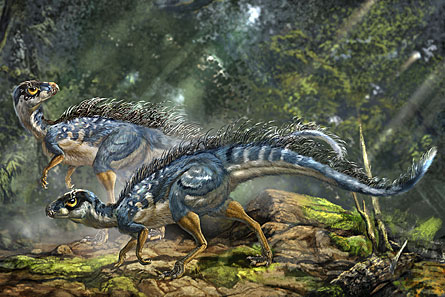Dino feathers may have had earlier origin than thought
Hairlike filaments found on 'wrong' side of dino family tree
Filaments preserved in newly described fossils hint that feathers, one hallmark of modern-day birds, may have originated from structures present on some of the earliest dinosaur species.

The fossil record indicates that feathers, besides covering all of today’s birds, also graced many an ancient dinosaur, says Hai-Lu You, a vertebrate paleontologist at the Chinese Academy of Geological Sciences in Beijing. Many research teams have found a variety of simpler structures — including peculiar, branched structures that paleontologists often call “dinofuzz,” as well as single unbranched filaments — on other fossils, he notes. Previously, though, all of those fine-scale body structures have been found on theropod dinosaurs (a group of largely carnivorous bipedal creatures) and their relatives in the saurichian, or lizard-hipped, side of the dinosaur family tree.
Now, in the March 19 Nature, You and his colleagues describe the fossils of an ornithischian, or bird-hipped, dinosaur that apparently sported filamentary structures on several parts of its body. The newly described creature, Tianyulong confuciusi, lived between 120 million and 130 million years ago in what is now northeastern China.
The team’s discovery marks the first time such filamentary structures have been seen in an ornithischian dinosaur, a find with big evolutionary implications. You and his colleagues suggest that such filaments evolved in a dinosaur that was a common ancestor for both ornithischians and saurischians and lived about 220 million years ago.
“Finding a Chinese dinosaur with feathers is not remarkable, but finding one on the wrong side of the dinosaur family tree is,” says Lawrence Witmer, a vertebrate paleontologist at Ohio University in Athens. “This is a surprise,” he adds.
It’s also possible that structures like Tianyulong’s filaments — which aren’t actually feathers but resemble what some paleontologists have proposed are an early stage in feather evolution (SN: 8/18/01, p. 106) — evolved several times in different dinosaur lineages, says Witmer. In some dinosaur groups, such as theropods, the structures evolved to become complex feathers, similar to those adorning today’s birds. “Perhaps the only clear conclusion that can be drawn … is that little Tianyulong has made an already confusing picture of feather origins even fuzzier,” he notes in an accompanying commentary in the same issue of Nature.
So far, only one fossil of Tianyulong has been unearthed, You says. The remains, which are probably from a young adult because some of the bones that make up each vertebra aren’t fully fused, suggest this individual was about 70 centimeters long, including a 44-centimeter tail.
The unusual features of Tianyulong, however, are filaments that apparently adorned three spots on the dinosaur’s body: underneath the creature’s throat, along its backbone and atop the base of its tail. All of the filaments, which were probably stiff because none are preserved in a bent position, measured about 0.4 millimeters across. The longest structures, those at the base of the creature’s tail, were about 6 centimeters long, You says.
Although some researchers have suggested that similar filaments preserved with other fossils are filaments of collagen from within the skin and not a body covering, You says the length of the filaments on the Tianyulong fossil — as well as the fact that the filaments on the back and tail project almost perpendicularly from the body — are “strong evidence” that the structures aren’t collagen.







